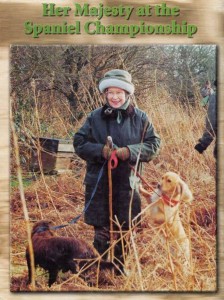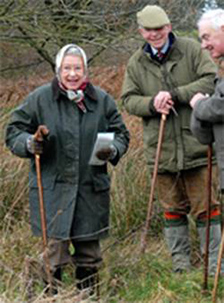Hunting Test Report – The Steadying of Your Spaniel
In the last issue we brought you up to speed on Willow. He is currently being steadied We started with the yard work, which is very basic. First, you hup the pup with a short check-cord on. We start with a retrieving buck, which is not too overly exciting.
With the pup sitting and your grip on the short lead, give a slight reminder by bringing the check cord to snug around his neck as you toss the buck. At the same time give the verbal command to hup in a firm tone. As many pups will do, Willow just couldn’t stand it and began jumping around, and wouldn’t sit back down. I insisted, and would not release him until he did finally calm down. This is so unnatural, and up until this point we have encouraged him to chase hard out to the buck or bird for the reward. Willow may be more gung-ho than many springers, and we knew this would come tough for him. This yard work usually goes fast and they soon realize that if they sit for a short time they will be sent right away for the retrieve. Willow took longer than most. It may be partly because he is strong willed, or just loves to retrieve, probably a little of both. The good news is that once he got the hang of it, he became very stable, even after moving from the buck to birds. It’s best to start out with dead birds and gradually move on to live clip wing birds as the pup becomes more comfortable with the yard work. With Willow, once he understood what was expected of him, (and he knew he would get the retrieve) he plopped his keester down and was just fine with the waiting.
We have moved on to the field, and continue to run him just as before, with one exception. We do not give him any fliers. We place clip-wing birds only in the field for him to find This gives the pup the fun of quartering, and finding game. This will keep his hunting desire strong through out the steady process. The birds that we put down must be prepared properly, you want the bird to attempt to flush, but cannot quite keep air borne. A bird that just lies in the cover, and makes no effort to flush is not going to help you keep that strong flush you must have. In fact just the opposite can happen, a bird planted that does not move puts off very little scent. Thus causing the youngster to have locating problems, and slow down at the wrong time. On the other hand the strong clip that is up and walking, or moving at least will produce much more of a scent cone for the oncoming dog. To give your pup the bird needed at this time, take about five of the longest wing feathers, and tape them very tightly together. This will give you a large gaping hole in one wing, but still allows a strong bird to flush and maybe fly low for a few feet. We use masking tape, one inch is best, and this is all you need to do to keep the pup flushing hard. Now; everything in training is variable so you may need to experiment with your pigeons to get the desired results. It may be six feathers, not five. What you do not want is too few feathers taped, this will allow the strongest of birds to not only flush, but continue to fly low for too long, giving the pup a chase rather than just a bird in the air that if not caught at once, will rapidly lose momentum and the pup will catch it.
Willow is doing just fine, running very hard and enjoying life even though we are taking him through the toughest part of spaniel training. This is the result you want, and that is why we never, ever completely take our young dogs out of the field when we go through the steady process. You know all is going well when a young dog con-tinues to quarter just as hard at this point as he did when you allowed him to flush and chase all out. As the young dogs continue to have fun finding game, flushing it, and catching it every time, they just love it. They return with the bird. As I take the retrieve, reaching down I get hold of the short check cord. The next step is an important one; I have the pup heel in a circle then hit the hup whistle. The pup now has to sit down of his own accord, and I then throw the bird for the retrieve. As the pup becomes accustomed to the routine they can’t wait to make the circle. Hupping on their own, they know I will then toss the bird, and have the gunners shoot it. Another successful retrieve and the pup is happy. This is a tough time for some, they now have to learn to mark the fall, and find the bird. A little different from chasing a bird and having it shot not too far from you. Many pups have problems with depth perception, but Willow is a natural marker. He flies out to the area of the fall and finds most retrieves quickly. The next step is to begin tossing clip wing birds for retrieves, as the pup is hupped out away from you. Begin by tossing the bird away from the dog but behind you so you are between the dog and the fall. Be prepared give the verbal command to hup as the bird is tossed. The pup may make a move toward the fall but you can stop him and insist he remain at the hup position until you release him by calling his name. From this you can begin tossing the bird off to the side, then progress to where he will remain hupped even as you toss the bird over his head away from you. He is now out were he could break so you must be on your toes, and maybe not hold him too long. At this point if you can read your dog, and tell by looking that he is on edge, or about to move. You can keep him honest by properly timing your whistle command to remain calm and stay sitting. Your experienced can make this go smoothly, while a novice can have the dog break over and over. It’s all a matter of reading the body English of the pup and knowing what he is going to do next. If you stay out front of the trainee things can go so smoothly. In the next issue we will continue with the field training and steady procedure, until then good training and good trialing/hunting. – JIM DeVOLL



